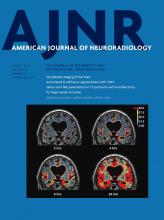We appreciate the comments from Drs Lecler, Sadik, and Savatovsky on our article, “Alterations in Blood-Brain Barrier Permeability in Patients with Systemic Lupus Erythematosus.” The comments are mainly focused on the permeability model used in dynamic contrast-enhanced (DCE)-MR imaging postprocessing. In our study, we used a commercially available software, Olea Sphere (Olea Medical, La Ciotat, France), using the Tofts and Kermode (TK) permeability model, to postprocess the acquired DCE-MR imaging data into blood-brain barrier permeability (BBBP) parameters of the volume transfer constant (Ktrans) and Ve. The authors suggest the use of a more complex pharmacokinetic model, the 2-compartment exchange model (2CX), which they state may overcome important limitations of our current model, to detect subtle changes in BBBP.
Different theoretic models have been proposed for DCE-MR imaging data analysis, including the TK and extended TK models, the adiabatic tissue homogeneity model, the 2CX model, the distributed capillary adiabatic tissue homogeneity model, and the γ capillary transit time model.1 The TK model used in our study, while less robust as indicated by the authors, is readily integrated into the clinical setting and is thus more practical from a clinical standpoint compared with the other aforementioned models. The TK model has previously been shown to overestimate Ktrans1; however, marked variability in Ktrans values across different models is a known issue affecting all models.2 Most important, even if absolute Ktrans values may have been overestimated in our study, all patients and controls were analyzed with the same model conditions; therefore, our conclusions regarding relative region-based and disease-based changes in Ktrans remain valid.
The 2CX model is a complex and robust pharmacokinetic model, as discussed by the authors, and provides 4 distinct parameters including 2 perfusion-related parameters and 2 permeability-related parameters. The authors have recently published a study on the application of the 2CX model in differentiating benign from malignant orbital tumors.3 This is a valuable contribution to the large body of literature comparing different DCE-MR imaging models, in which the authors state that regardless of the permeability model used, there were no differences in their conclusions.
The TK model used in our study has previously been applied in the detection of subtle permeability changes.4 While there are certain inherent disadvantages to the TK model, our study, nevertheless, revealed statistically significant BBBP differences in patients with systemic lupus erythematosus (SLE) compared with healthy controls. We would, in fact, expect similar results with any of the aforementioned models, including the 2CX. If anything, the 2CX model may augment the differences observed between the SLE and healthy control groups.
Furthermore, the purpose of our study was not to compare permeability models or parameters. We used a commonly used commercial software and found statistically significant results comparing patients with SLE with healthy controls. One of the points of this exercise was to expand the usefulness of these complex models so that their clinical efficacy could be tested. Therefore, we are in substantial agreement with the authors' recently published study.3 However, we acknowledge that the application of the 2CX model to assess BBBP across different disease or stress states of patients with SLE remains to be fully evaluated.
Although we described 80 cine phases being performed in our imaging protocol, we take this opportunity to add that the total acquisition time for the DCE-MR imaging sequence was 11 minutes 14 seconds. While we agree with the authors that a minimal duration of 10 minutes for DCE acquisitions will increase the detectability of BBBP changes, these benefits to the physics of the protocol must be weighed against the biology we are attempting to understand and the risk to that biology (for example, patient tolerability and renal clearance of gadolinium).5
As in almost all past work with brain imaging, larger studies are needed to validate the findings in our study. We stated in our Conclusion: “These initial data are proof-of-concept which support our hypothesis that the BBB is selectively compromised, particularly in the hippocampus region in SLE subjects with little to no disease activity and no history of CNS insult who demonstrate impaired performance on cognitive testing. The significance of these findings may advance our understanding of the underlying pathophysiologic mechanisms affecting the brain in autoimmune diseases. Importantly, larger studies are necessary to validate these results and confirm the value of DCE-MR imaging methodology as a potential biomarker for blood-brain barrier permeability imaging.”
We appreciate the authors' interest in our study. We hope our reply clarifies that the purpose of our study was not to determine the optimal pharmacokinetic model, BBBP parameters, or imaging protocol to use in assessing BBBP in patients with SLE. While our study used a debatably less sensitive permeability model, its clinical effectiveness and usefulness have detected BBBP alterations in patients with SLE, a clinically important addition to the literature in this disease. We would like to emphasize, and think the authors would agree, that more robust permeability models would not necessarily alter this conclusion. We acknowledge that our study reveals initial proof-of-concept findings that warrant further investigations.
- © 2019 by American Journal of Neuroradiology







